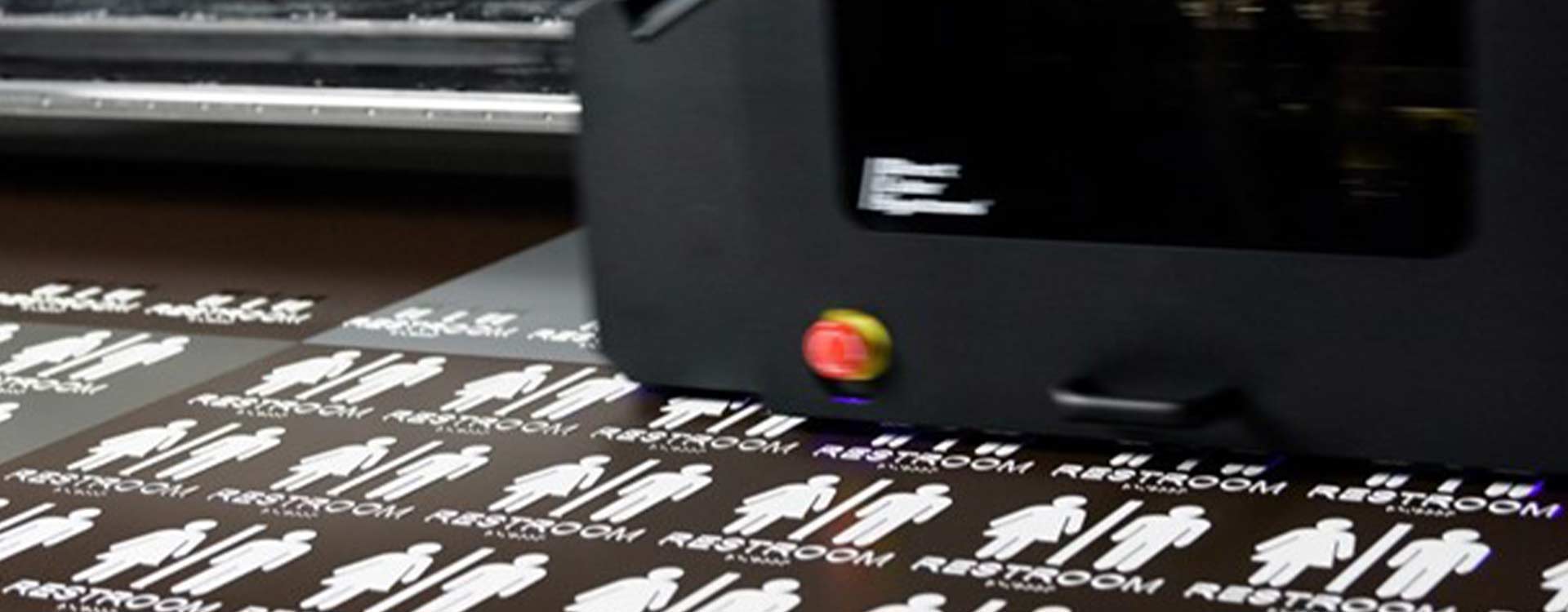
The power of a printer is not to be underestimated in the world of signage, an industry where consumers need quick product turnaround. Ensuring that the most time-intensive and detailed aspects can be done with speed will satisfy your clients. In addition to expecting fast delivery of their signage, your clients expect high-quality graphics that accurately depicts their aesthetic desires. The signage industry has seen photopolymer printing, engravings, etchings, and metal casting, but one of the best solutions on the market today is UV printing.
UV printing produces any desired texture on signage with minimal human involvement. The UV application process reduces both your labor costs and your risk of reprinting due to an error. This technology can significantly improve the creation of interactive installments, ADA signage, and cohesive signage systems by being quick and easy to use.
How Does UV Printing Work?

UV Printing utilizes UV light sensitive ink. The ink prints in layers and hardens on a plethora of substrates for impressive detailing. In addition to this, incredible images and textures can be printed by combining clear ink with other ink layers. UV printers can print on virtually any kind of surface, from metals, PVC, acrylics, and even three-dimensional objects. By printing layers directly onto the sign, it can now serve both purposes of matching an image behind it and aid ADA navigation. One of the best aspects of UV printing is that the ink immediately cures after printing. The signs are ready for shipment right after a quality check – avoiding scheduling in time for materials to dry.
When using UV printing, your product offerings would expand as you can offer high quality and more unique designs – all at a faster pace.
Photopolymer is of the Past
A popular way of creating printed graphics on signage is through photopolymer printing. This complex process requires several steps to remain error-free to avoid costly re-prints. First, a light sensitive polymer resin is exposed to the desired graphic or image. After light exposure, the emulsion is then washed off, and the resin dries before entering another light curation process. The resin hardens with the image now embossed on it. The graphics or signs are usually printed on to the resin as a set, so the resin signs must then be cut individually before being silk-screened or hot-pressed with ink.
This process is wasteful and time-consuming. Compared to the simplicity of today’s UV printing, all you need is ink, substrate, and printer. There are many opportunities during the photopolymer process where errors can occur. This can lead to costly wasted materials, project delays, and reputational damage with your client. With UV printing, there is no need to worry about the level of texture coming through, correct color being pressed on, or distorted text and icons.
Enhance Your ADA Signage
UV printing is a technological breakthrough in the world of creating ADA signage at the speed of light. Most – if not all – public locations require ADA-compliant signage and the demand continues to grow. A UV printer with patented technology to fulfill the ADA requirements of size, gloss level, and other standards using its texturing capabilities will increase output and reduce cost.
Offering ADA signage is a sign to your clients that you can meet a range of demands and garner revenue. There are several ways to achieve ADA braille textures with engravings, photopolymer, cast metal, and raster braille, but none match up to the speed and accuracy of UV printing.
As technology continues to improve every industry, the signage and printing industry is impacted positively by the power and speed of UV printing. As your signage business grows in interest, you are fully capable of meeting demand with quickly fulfilling schedules, and maintaining a low cost with efficient printing methods. These benefits only continue when you are able to expect the highest quality print with your product. Producing the most precise texturing and up to code ADA requirements is what your clients are looking for.
